Introduction
Physical therapy in Elko for Hand
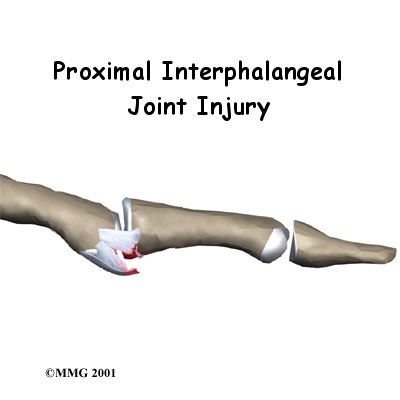
Welcome to Pinion Rehabilitation's patient resource about PIP Joint Injuries of the Finger.
We use our hands constantly, placing them in harm's way continuously.Injuries to the finger joints are common and usually heal without significant problems. Some injuries are more serious and may develop problems if not treated carefully. One such injury is a sprain of the proximal interphalangeal joint, or PIP joint, of the finger. This joint is one of the most unforgiving joints in the body to injury. What appears at first to be a simple sprain of the PIP joint may result in a painful and stiff finger, making it difficult to use the hand for gripping activities.
This article will help you understand:
- what parts make up the PIP finger joint
- what types of injuries affect this joint
- how the injury is treated
- what to expect from treatment
#testimonialslist|kind:all|display:slider|orderby:type|filter_utags_names:Hand Pain|limit:15|heading:Hear from some of our patients who we treated for *Hand Pain*#
Anatomy
What parts of the finger are involved?
The work like hinges when the fingers bend and straighten. The main knuckle joint is the metacarpophalangeal joint (MCP joint). It is formed by the connection of the metacarpal bone in the palm of the hand with the finger bone, or phalange. Each finger has three phalanges, separated by two interphalangeal joints (IP joints). The one closest to the MCP joint (knuckle) is called the proximal IP joint (PIP joint). The joint near the end of the finger is called the distal IP joint (DIP joint).
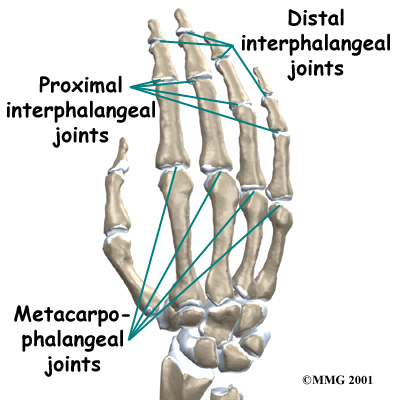
Ligaments are tough bands of tissue that connect bones together. Several ligaments hold the joints together. In the PIP joint, the strongest ligament is the .
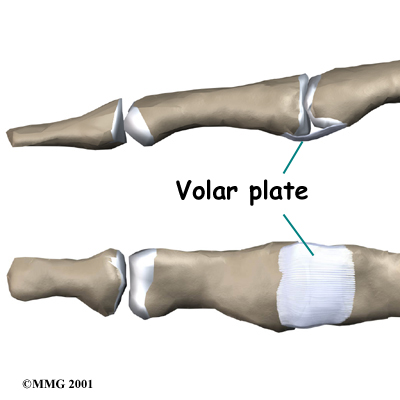
This ligament connects the proximal phalanx to the middle phalanx on the palm side of the joint. The ligament tightens as the joint is straightened and keeps the joint from hyperextending. There is also a collateral ligament on each side of the PIP joint. The tighten when the joint is bent sideways and keep the joint stable from side to side.
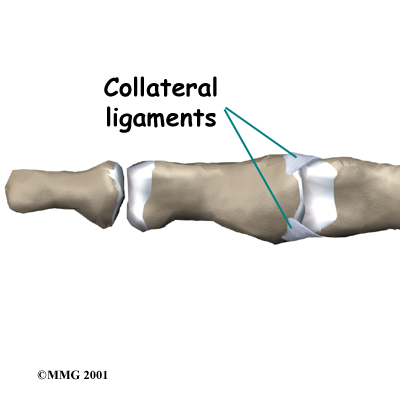
Related Document: Pinion Rehabilitation's Guide to Hand Anatomy
Hand Anatomy Introduction
Causes
How do these injuries of the PIP joint occur?
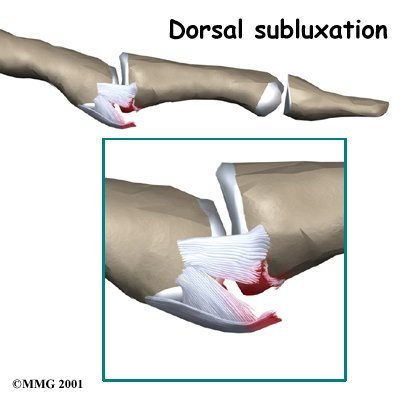 A sprain is a general term that means a ligament is injured.
A sprain is a general term that means a ligament is injured.
Doctors usually use this term to mean that the ligament has been stretched and partially torn. If the ligament is stretched too far, it ruptures or tears completely.
Injury to the volar plate can occur when the joint is hyperextended. If a occurs, the ligament usually ruptures or tears from its attachment on the middle phalanx.
There may be a small piece of bone avulsed (pulled away) from the middle phalanx when this occurs.
If it is small it is usually of no consequence, but if it is large and involves a significant amount of the joint surface it may require surgery to fix the fragment and restore the joint surface.
Injury to the collateral ligaments can occur when the joint is forced to bend too far sideways until one of the . These ligaments can also be injured if the PIP joint is actually dislocated, with the middle phalanx dislocating behind the proximal phalanx.
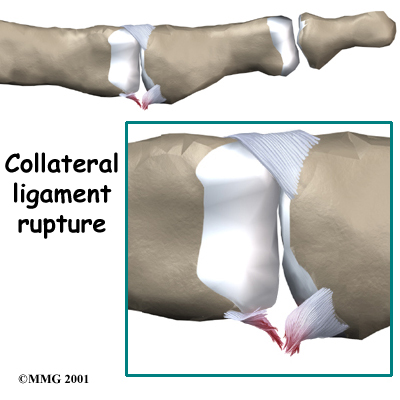
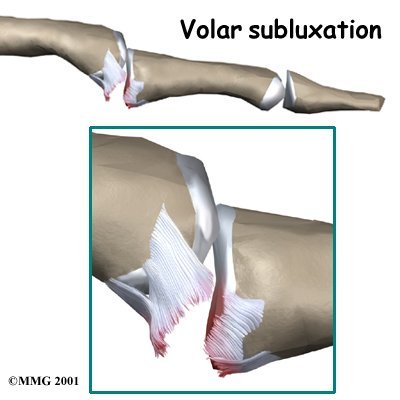
Symptoms
What do PIP joint injuries look and feel like?
Initially, the finger is painful and swollen around the PIP joint. If the joint has completely dislocated it will appear deformed.
Diagnosis
When you visit Pinion Rehabilitation, our physical therapist will first take a history and do a physical examination. Usually the diagnosis of PIP joint injury is evident just from the physical exam.
Some patients may be referred to a doctor for further diagnosis. X-rays may be required to see if there is an associated avulsion fracture since this may change the recommended treatment. X-rays are also useful to see if the joint is aligned properly after an injury or after the reduction of a dislocation. No other tests are required normally.
Once your diagnostic examination is complete, the physical therapists at Pinion Rehabilitation have treatment options that will help speed your recovery, so that you can more quickly return to your active lifestyle.
Our Treatment
Non-surgical Rehabilitation
When the ligaments have been sprained or partially torn, your physical therapist may simply advise a short period of splinting and early exercise. The PIP joint is very sensitive to injury and becomes stiff very rapidly when immobilized for even short periods of time. The faster the joint begins to move the less likely there will be a problem with stiffness later on. Many sprains can be treated with simple buddy taping to the adjacent finger. This allows the good finger to brace to the injured finger while at the same time using the good finger to bend the injured finger as the hand is used.
When the volar plate has been completely ruptured or when the joint has been dislocated, nonsurgical treatment is still usually suggested. Our goal is to keep the joint in a stable position while beginning motion as soon as possible. Since the injury results from hyperextension, our therapist will have you use a brace to prevent the joint from straightening completely while still allowing the joint to bend. This brace is called a dorsal blocking splint, and is usually worn for three to four weeks until the ligament heals enough to stabilize the joint.
In some cases when the volar plate ruptures, it may get caught in the joint and prevent the therapist from reducing (realigning) the joint. In this case we may refer you for surgical evaluation.
Although the time required for recovery is different for each patient, if nonsurgical treatment is successful, you may see improvement in about three to six weeks. By wearing a dorsal blocking splint, the joint continues to bend freely but is kept from straightening completely.
After approximately three to four weeks, the joint should heal enough to remove the splint and begin strengthening exercises. Our physical therapist will develop a personalized exercise program to help you recover the range-of-motion and strength in your fingers.
Injuries to the PIP joint remain swollen for long periods of time. Commonly, the joint will be permanently enlarged due to the scarring of the healing process. This may cause problems with getting rings on and off. It is a good idea to wait for about one year before the ring is resized since the scarring will continue to remodel. The joint will gradually get smaller and in some cases may return to its original size.
Post-surgical Rehabilitation
Plan to wear a splint or brace for about three weeks after surgery to give the repair time to heal. Although recovery time varies among individuals, after surgery you will likely need to attend therapy sessions for two to three months, and you should expect full recovery to take up to four months.
Your first few physical therapy treatments will focus on controlling the pain and swelling from surgery. Then our physical therapist will start you on gentle range-of-motion exercise. Strengthening exercises are then used to give added stability around the finger joint. Our physical therapist will teach you ways to grip and support items in order to do your tasks safely and with the least amount of stress on your finger joint. As with any surgery, you need to avoid doing too much, too quickly.
Eventually, we will have you begin doing exercises designed to get your hand and fingers working in ways that are similar to your work tasks and daily activities. Our physical therapist will help you find ways to do your tasks that don't put too much stress on your finger joint. Before your physical therapy sessions end, we will teach you a number of ways to avoid future problems.
Our goal is to help you keep your pain under control, improve your strength and range of motion, and regain fine motor abilities with your hand and finger. When your recovery is well under way, regular visits to Pinion Rehabilitation will end. Although we will continue to be a resource, you will be in charge of doing your exercises as part of an ongoing home program.
Pinion Rehabilitation provides services for physical therapy in Elko.
Surgery
In severe cases, surgery is necessary to repair extensive damage to the collateral ligaments or volar plate. Surgery is also necessary to remove the volar plate if it becomes trapped in the joint and prevents the surgeon from realigning the joint without surgery.
Portions of this document copyright MMG, LLC.


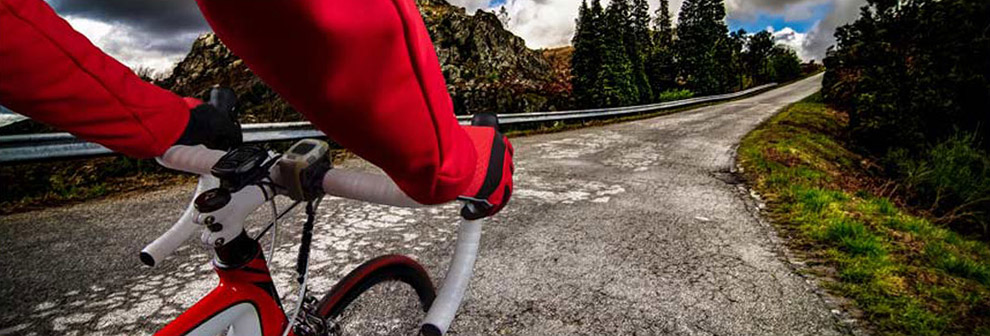
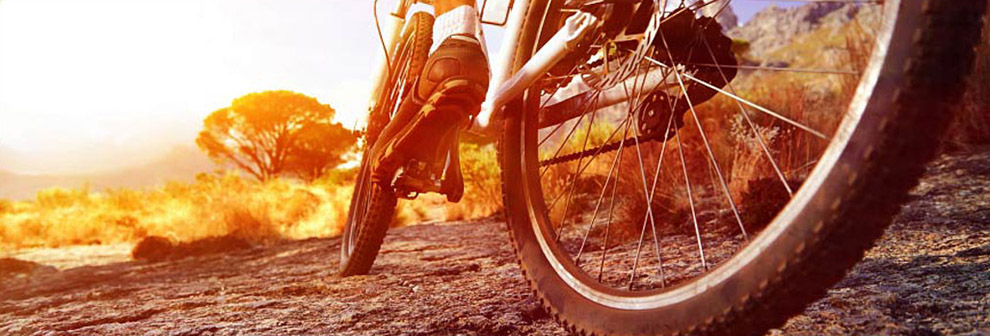
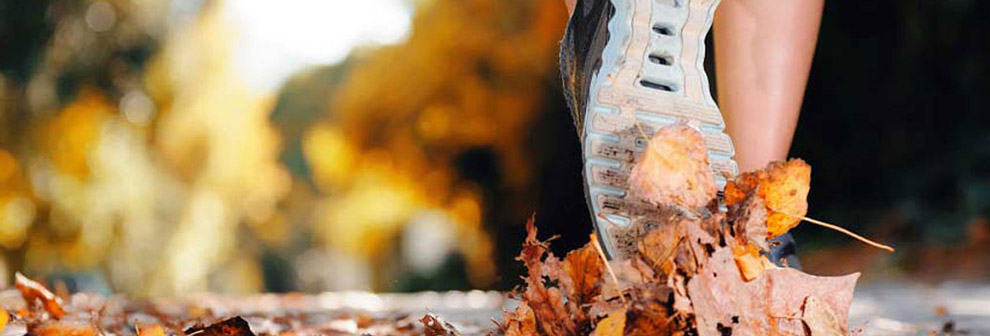
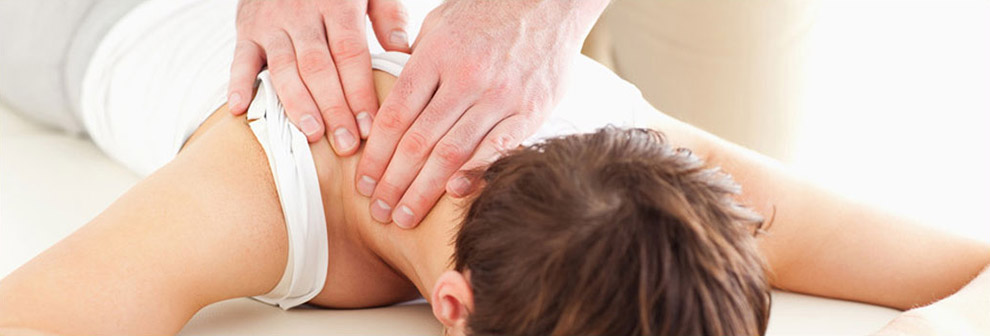
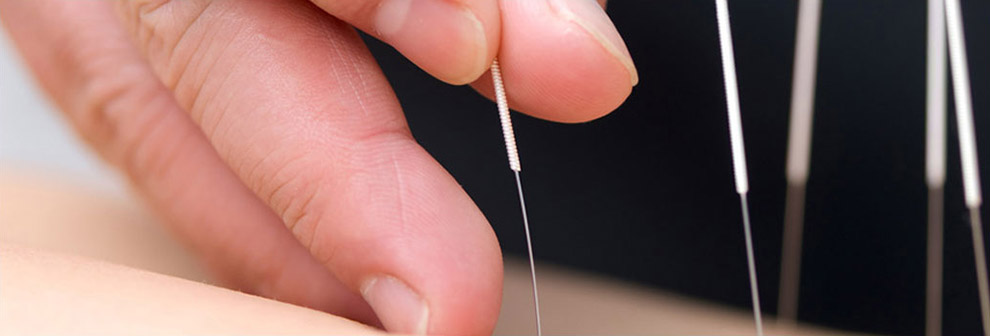
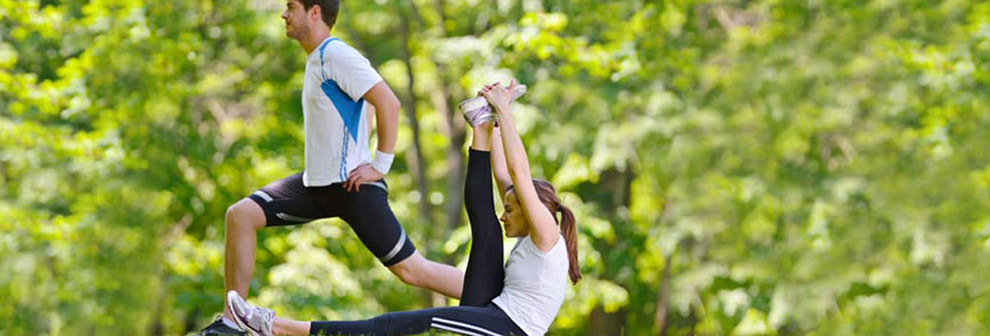





 A sprain is a general term that means a ligament is injured.
A sprain is a general term that means a ligament is injured.

